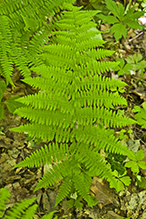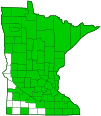lady fern
(Athyrium filix-femina)
Overview • Description • Distribution • Taxonomy
Lady fern is often cultivated for its attractive foliage as a garden ornamental. It is relatively easy to grow and relatively pest-free and disease-free. It also provides food and shelter for a variety of animals. It has been used to treat a variety of ailments, including arthritis, gout, and kidney stones. |
||
Description |
||
Lady fern is a relatively large, delicate, perennial fern. Several fronds rise from a short-creeping rhizome and fibrous roots, forming a compact, more or less circular cluster. The fronds are deciduous, up to 120 cm long, light green, and lacy in appearance. They are divided into 30 to 40 leaflets (pinnae), and the pinnae are divided into smaller pinnules. The stem (stipe) has numerous, scattered, brown to dark brown, linear to egg lance-shaped, chaffy scales. Fertile and infertile fronds are similar in appearance. The spore-bearing structures (sori) on the underside of fertile fronds are kidney-shaped and covered by a protective veil (indusium). The indusium is attached to one side of the sorus. |
||
Distribution |
||||
|
Sources |
|||
| 5/29/2024 | ||||
Taxonomy |
|||
| Kingdom | Plantae (green algae and land plants) | ||
| Subkingdom | Viridiplantae (green plants) | ||
| Infrakingdom | Streptophyta (land plants and green algae) | ||
| Superdivision | Embryophyta (land plants) | ||
| Division | Tracheophyta (vascular plants) | ||
| Subdivision | Polypodiophytina | ||
| Class | Polypodiopsida (ferns) | ||
| Subclass | Polypodiidae | ||
Order |
Polypodiales (true ferns) | ||
Suborder |
Aspleniinae (eupolypods II) | ||
Family |
Athyriaceae (ladyferns and allies) | ||
Genus |
Athyrium (lady ferns) | ||
| Section | Athyrium | ||
There is considerable disagreement on the number and classification of the varieties of Athyrium filix-femina. Four varieties were traditionally recognized. The names of the varieties are one source of disagreement. Various authors have elevated one or more of the varieties to full species status. How many and which ones is another source of disagreement. Of the varieties, only northern lady fern (Athyrium filix-femina var. angustum) occurs outside of cultivation in Minnesota. When treated as a species, it is Athyrium angustum. Update |
|||
Subordinate Taxa |
|||
northern lady fern (Athyrium filix-femina var. angustum) northwestern lady fern (Athyrium filix-femina var. cyclosorum) southern lady fern (Athyrium filix-femina var. asplenioides) southwestern lady fern (Athyrium filix-femina var. californicum) |
|||
Synonyms |
|||
|
|||
Common Names |
|||
common lady fern common ladyfern lady fern ladyfern subarctic lady fern subarctic ladyfern |
|||
Visitor Photos |
|||||
Share your photo of this plant. |
|||||
| This button not working for you? Simply email us at info@MinnesotaSeasons.com. Attach one or more photos and, if you like, a caption. |
|||||
|
|||||
MinnesotaSeasons.com Photos |
|||||
|
|||||

Slideshows |
||
| Lady Fern - Athyrium filix femina - Plant TV Plant TV |
||
About
Published on Apr 11, 2014 Lady Fern - Athyrium filix femina You may have Lady fern in your own house. Many people use it to decorate their homes. You may see it hanging or potted. People in Victorian times were crazy about Lady fern. However, Lady fern is not only found in the house. It also grows in the wild, especially in deciduous forests and the taiga of North America and Eurasia. Lady Fern is a deciduous, perennial fern about 24 to 36 inches tall. Its light green, lacy leaves are about 24 to 30" long and 6 to 9" wide and tapered at both ends. The fronds are cut twice and grow from a central base. The J-shaped spore casings, or sori, grow on the underside of the leaf. |
||

Visitor Videos |
|||
Share your video of this plant. |
|||
| This button not working for you? Simply email us at info@MinnesotaSeasons.com. Attach a video, a YouTube link, or a cloud storage link. |
|||
Other Videos |
|||
| Lady Fern Joe Addair |
|||
About
Uploaded on Sep 23, 2011 another great plant/herb for the ladies |
|||
| Athyrium filix femina wander van laar |
|||
About
Published on Jun 14, 2014 No description available. |
|||

Visitor Sightings |
|||||
Report a sighting of this plant. |
|||||
| This button not working for you? Simply email us at info@MinnesotaSeasons.com. Be sure to include a location. |
|||||
|
|||||
MinnesotaSeasons.com Sightings |
|||||
Avon Hills Forest SNA, North Unit Bertram Chain of Lakes Regional Park Carpenter St. Croix Valley Nature Center Charles A. Lindbergh State Park Clifton E. French Regional Park Forestville/Mystery Cave State Park Hardscrabble Woods / MG Tusler Sanctuary John Peter Hoffman Spring Brook Valley WMA Lake Alexander Woods SNA, South Unit Mary Schmidt Crawford Woods SNA Nerstrand Big Woods State Park Robert Ney Memorial Park Reserve Spring Beauty Northern Hardwoods SNA |
|||||

|
Created: Last Updated: © MinnesotaSeasons.com. All rights reserved. |

